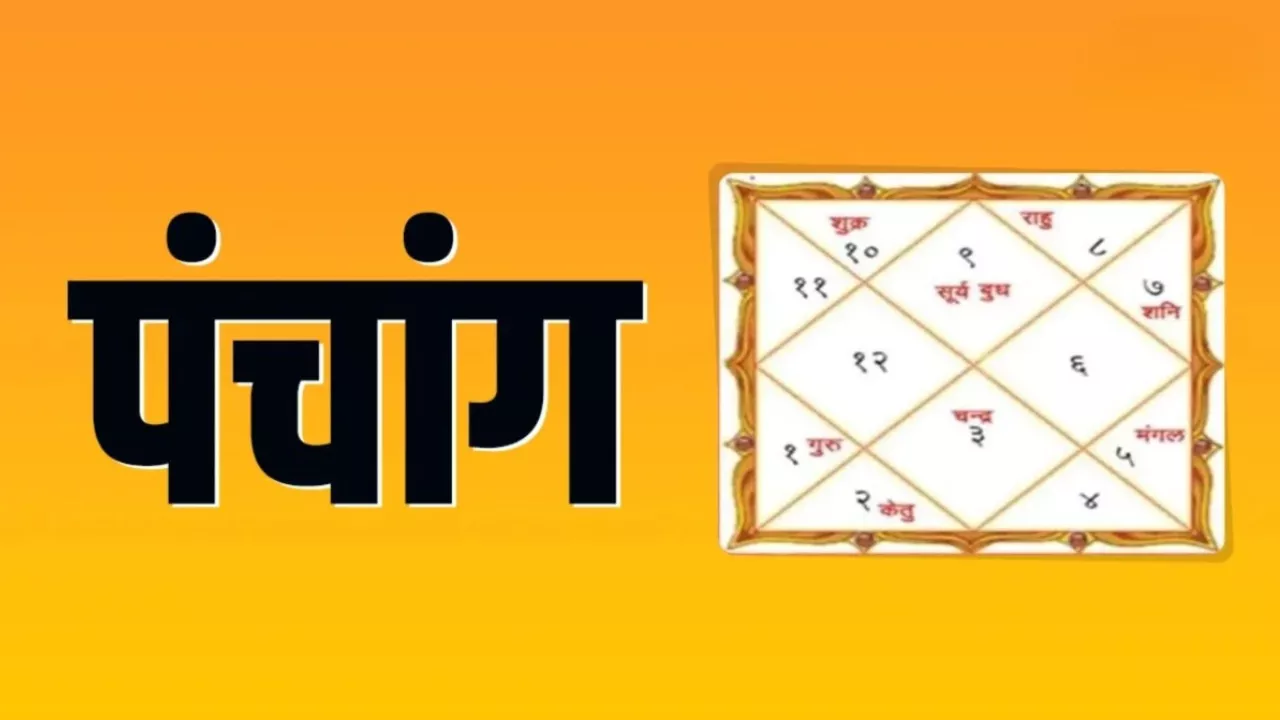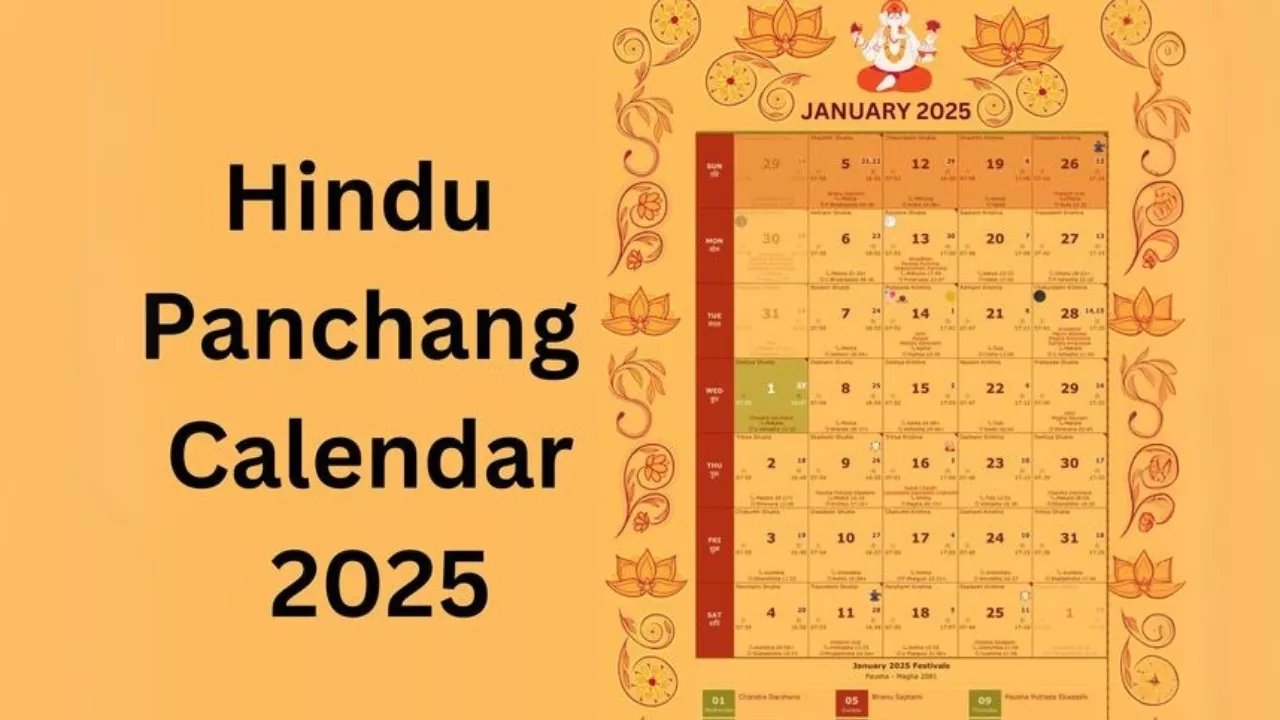Namaste,
This celestial guide that helps us navigate our lives according to the rhythms of the cosmos and the wisdom of Dharma. The Panchang is key to performing our duties, especially the solemn and vital rites of Pitṛ Pakṣa, with precision and devotion.
Panchang not merely is a calendar you hang on the wall. It is a living reflection of Mahākāla (Great Time), charting the intricate dance between the Sun (Sūrya), the Moon (Chandra), and the stars (Nakṣatras). It provides the coordinates needed to align our actions with auspicious moments, ensuring our efforts, particularly our offerings to the Pitṛs (ancestors), yield the greatest spiritual benefit.

The very word Pañcāṅga means ‘Five Limbs’ (pañca = five, aṅga = limb). As the revered Agni Purāṇa confirms, these five core elements together paint a picture of the day’s unique energetic signature. Understanding these is fundamental to correctly observing Pitrupaksha. Let us examine each limb:
Your Essential Panchang Guide to Pitrupaksha, Nakshatra & More

- Vāra (Weekday): The simplest limb, representing the seven days (Sunday to Saturday), each ruled by a planet (Sun, Moon, Mars, Mercury, Jupiter, Venus, Saturn). While every day has its subtle influence, for Śrāddha, the Vāra is generally less critical than the Tithi in determining the primary day of observance. However, some traditions might avoid performing rites on days ruled by natural malefics if other options are available, or find significance in certain conjunctions (like Somavati Amavasya – Amavasya falling on a Monday, considered highly auspicious for Pitṛ rites, as mentioned in the Vāmana Purāṇa).
- Tithi (Lunar Day): A Tithi is not a fixed 24-hour period like a solar day. It is defined by the Moon’s movement relative to the Sun. Specifically, it is the time taken for the longitudinal angle between the Moon and the Sun to increase by exactly 12 degrees. Since the Moon’s speed varies, Tithis can differ slightly in duration (roughly 19 to 26 hours).
- Two Pakṣas (Fortnights): A full lunar month (māsa) has 30 Tithis, divided into two fortnights (pakṣas):
- Śukla Pakṣa (Bright Half): From the New Moon (Amāvāsyā) to the Full Moon (Pūrṇimā). The Moon waxes (grows brighter). The Skanda Purāṇa calls this fortnight Pūrṇa (complete), associated more with rites for the Devas.
- Kṛṣṇa Pakṣa (Dark Half): From the Full Moon to the New Moon. The Moon wanes (grows darker). Pitrupaksha falls entirely within the Krishna Paksha of the Bhadrapada month (as per Purnimanta calendar) or Ashwin month (as per Amanta calendar).
- The Pitṛs’ Day and Night: The Skanda Purāṇa offers a profound insight: it states that a lunar month constitutes one “day” for the Pitṛs. The dark fortnight (Kṛṣṇa Pakṣa) is their daytime, when they are most active and receptive to offerings, while the bright fortnight (Śukla Pakṣa) is their night-time. This is why Śrāddha is primarily performed during the Krishna Paksha, and Pitrupaksha, falling entirely in this period, becomes the most concentrated time for these rites.
- The Cardinal Rule for Śrāddha: The fundamental principle is to perform the annual Śrāddha for an ancestor on the specific Tithi (in the Krishna Paksha of the appropriate month, usually Bhadrapada/Ashwin during Pitrupaksha) on which they left their mortal coil. This precise alignment ensures the offerings reach them most effectively.
- Significance of Each Tithi in Pitrupaksha: The Brahma Purāṇa notes that Śrāddha performed on different Tithis during Pitrupaksha (when the Sun is in Virgo/Kanya) yields specific blessings. While not exhaustive, here are some examples mentioned or traditionally held:
- Pratipadā (1st Tithi): Gain of wealth.
- Dvitīyā (2nd Tithi): Acquisition of progeny, beautiful spouses.
- Tṛtīyā (3rd Tithi): Fulfillment of desires related to progeny.
- Chaturthī (4th Tithi): Victory over enemies.
- Pañcamī (5th Tithi): Attainment of prosperity (Lakṣmī).
- Ṣaṣṭhī (6th Tithi): Attainment of splendor and honour.
- Saptamī (7th Tithi): Gain of lordship or leadership qualities.
- Aṣṭamī (8th Tithi): Attainment of complete intelligence (sampūrṇa buddhi).
- Navamī (9th Tithi): Auspicious for honouring deceased married women (avidhavā navamī). Gain of feminine energy, vehicles.
- Daśamī (10th Tithi): Fulfillment of all desires related to senses.
- Ekādaśī (11th Tithi): Attainment of Vedic knowledge and wealth.
- Dvādaśī (12th Tithi): Victory, progeny, nourishment. Important for honouring departed Sanyasis (ascetics).
- Trayodaśī (13th Tithi): Progeny, intelligence, longevity, prosperity.
- Chaturdaśī (14th Tithi): Crucially designated for those who suffered untimely/violent deaths (apad mṛtyu, durmaraṇa), as confirmed by Skanda and Agni Purāṇas. Not generally used for ancestors who died naturally unless it was their specific death tithi.
- Amāvāsyā (15th Tithi – New Moon): The most vital day, Sarva Pitru Amavasya. Designated for all ancestors, especially those whose death tithis are unknown or forgotten. The Skanda and Garuḍa Purāṇas extol its virtues, making it the ultimate Panchang guide Pitrupaksha solution for universal remembrance.
- Two Pakṣas (Fortnights): A full lunar month (māsa) has 30 Tithis, divided into two fortnights (pakṣas):
- Nakṣatra (Lunar Mansion): This refers to the segment of the ecliptic (the Sun’s apparent path) in which the Moon resides at a given time. There are 27 Nakshatras, each spanning 13 degrees and 20 minutes, and each governed by a specific deity imparting unique qualities. The Nakshatra active during the Śrāddha can add subtle layers of influence and potency.
- Checking the Nakshatra: A Panchang will list the prevailing Nakshatra for the day, often specifying the time until which it is active, after which the next Nakshatra begins.
- Key Nakshatras for Pitrupaksha/Śrāddha:
- Bharani: As discussed, ruled by Lord Yama, the Lord of Pitṛs. Its occurrence during Pitrupaksha (Maha Bharani) is considered exceptionally potent for ancestral rites, traditionally held equivalent in merit to performing Śrāddha at Gaya.
- Maghā: This Nakshatra is strongly associated with ancestors. The phrase “Maghāsu pitaraḥ smṛtāḥ” (Pitṛs are remembered during Maghā) is well-known. Performing Śrāddha under Maghā Nakshatra (even outside Pitrupaksha) is considered highly beneficial for ancestral satisfaction. Its occurrence during Pitrupaksha naturally enhances its value.
- Rohiṇī, Mṛgaśiras, Ārdrā: These Nakshatras, along with others, are mentioned in texts like the Mārkaṇḍeya Purāṇa as yielding specific benefits when Śrāddha is performed under their influence (e.g., desired objects, brilliance, victory over enemies, respectively). While the context might be general Śrāddha, their positive associations add value if they fall during Pitrupaksha.
- Hasta: As mentioned in the Skanda Purāṇa, the Sun’s transit in Virgo (Kanyā Rāśi), often coinciding with Hasta Nakshatra, marks the highly auspicious Mahalaya period itself, making Hasta significant.
- Pūrvāṣāḍhā & Uttarāṣāḍhā: The Mārkaṇḍeya Purāṇa links Śrāddha under Ashadha Nakshatras to fame and freedom from sorrow.
- Dhaniṣṭhā & Śatabhiṣaj: Linked to gaining wealth and proficiency in healing, respectively, through Śrāddha in the same text.
- While Tithi determines which day to perform the Śrāddha for a specific ancestor, the prevailing Nakshatra can indicate the quality of that day’s energy for the rite, with Bharani and Magha being particularly noteworthy during Pitrupaksha.
- Yoga (Auspicious/Inauspicious Combination): This limb is calculated based on the combined longitudes of the Sun and Moon. There are 27 Yogas, each lasting approximately as long as a Nakshatra. They indicate the general auspicious or inauspicious nature of the time for various activities.
- Significance for Śrāddha: Certain Yogas are considered particularly powerful and meritorious for performing Śrāddha and acts of charity (dāna).
- Vyatipāta: Mentioned explicitly by both the Skanda Purāṇa and Garuḍa Purāṇa as a time when Śrāddha yields immense, potentially inexhaustible results (akṣaya phala). Vyatipata represents a time of specific astronomical alignment, often considered somewhat volatile but highly potent for spiritual practices aimed at dissolving negativity or performing rites for ancestors.
- Vaidhṛti: Similar to Vyatipata, Vaidhriti Yoga is also highly praised for performing Śrāddha, japa (mantra chanting), and dāna. Offerings made during these Yogas are believed to be exceptionally pleasing to the Pitṛs.
- Checking the Yoga: The Panchang will list the active Yoga for the day and its duration. If performing Śrāddha on the correct Tithi happens to coincide with Vyatipata or Vaidhriti Yoga, the merit is considered significantly amplified.
- Significance for Śrāddha: Certain Yogas are considered particularly powerful and meritorious for performing Śrāddha and acts of charity (dāna).
- Karaṇa (Half Lunar Day): Each Tithi is divided into two Karaṇas. There are 11 Karaṇas in total – 7 movable (Chara) and 4 fixed (Sthira). They add another layer of refinement to the day’s astrological quality.
- Relevance: While important for determining muhūrta (auspicious timing) for various activities like starting journeys, business deals, or ceremonies, the specific Karaṇa is generally considered less critical for Śrāddha timing compared to the Tithi, Nakshatra, and specific Yogas like Vyatipata.
- Viṣṭi Karaṇa (Bhadrā): One specific Karana, Viṣṭi, commonly known as Bhadrā, is generally considered inauspicious for starting most positive activities. While its direct impact on Śrāddha performance might be less emphasized than for other rituals, some may prefer to avoid the Bhadrā period if possible, though the Tithi remains the overriding factor.
Applying the Panchang Guide Pitrupaksha: Practical Steps
So, how does one use this knowledge during Pitrupaksha?
- Identify the Correct Tithi: This is paramount. Determine the lunar day (tithi) on which your ancestor passed away. The Śrāddha should ideally be performed on that same tithi when it occurs during the Krishna Paksha of Bhadrapada/Ashwin. (E.g., If someone died on the 5th day of the dark fortnight, their Śrāddha is performed on the Pañcamī Tithi during Pitrupaksha).
- Consult a Reliable Panchang: Obtain a trustworthy Panchang for the current year. This can be a traditional printed almanac or a reliable online source/app adhering to established calculation methods (Dṛk gaṇita is often preferred for accuracy).
- Locate the Tithi: Find the date(s) during Pitrupaksha when the specific Tithi falls. Note the start and end times of the Tithi, as it might span across two solar days. Tradition often emphasizes performing the main Śrāddha rites, especially Piṇḍa Dāna, during the Aparāhna Kāla (afternoon period, roughly 1:30 PM to 4:00 PM) of the day when the Tithi prevails.
- Check for Unknown Tithis: If the death tithi is unknown, mark the date of Sarva Pitru Amavasya in your Panchang. This is your primary day for observance.
- Note Key Nakshatras: See which Nakshatra is prevailing on the chosen Tithi. If it happens to be Bharani (Maha Bharani) or Magha, consider it especially auspicious.
- Look for Potent Yogas: Check if Vyatipata or Vaidhriti Yoga coincides with your chosen Tithi or Amavasya. Performing rites or charity during these Yoga periods enhances the merit.
- Consider Aparāhna Kāla: Aim to perform the core rituals during the afternoon (Aparāhna) period on the designated day.
- Seek Expert Guidance: When in doubt, consulting a knowledgeable family priest (purohit) or a learned astrologer (jyotiṣī) who understands Śrāddha procedures and Panchang calculations is always the wisest course. They can provide personalized guidance based on your specific family traditions and circumstances.
Beyond the Five Limbs: Other Considerations

While the five limbs form the core of the Panchang, other factors are sometimes noted:
- Rāhu Kāla, Gulika Kāla, Yamagaṇḍa Kāla: These are specific periods of the day considered inauspicious for starting new ventures. While generally avoided for auspicious beginnings, their applicability to Śrāddha (which is a duty, not necessarily an ‘auspicious start’) can be debated. Following family tradition or priestly advice is best here. Tithi and Aparahna Kala usually take precedence.
- Muhūrta: For many rituals, a specific auspicious time window (muhūrta) is calculated considering multiple Panchang factors. For Śrāddha, the primary ‘muhurta’ is the Aparāhna Kāla on the correct Tithi.
Conclusion: Navigating Pitrupaksha with Your Panchang Guide
The Pañcāṅga is truly an invaluable Panchang guide to Pitrupaksha. It allows us to move beyond guesswork and perform our sacred duties towards our ancestors with temporal precision, aligning our actions with the cosmic energies deemed most conducive by our ancient seers.
Focus primarily on identifying the correct Tithi. Let this be your anchor. Then, enrich your observance by noting the prevailing Nakshatra (especially Bharani or Magha) and potent Yogas like Vyatipāta or Vaidhṛti. Use a reliable Panchang and don’t hesitate to seek guidance.
But above all, remember the essence. The Skanda Purāṇa reminds us that the very word Śrāddha stems from Śraddhā – faith. While the Panchang provides the perfect timing, it is the faith in your heart, the love for your ancestors, the sincerity of your intention (bhāva), and the devotion (bhakti) with which you make the offerings that truly sanctify the rite and ensure it reaches the intended souls.
May this understanding of the Panchang illuminate your path as you honour your revered Pitṛs during this sacred fortnight. May your ancestors receive your offerings with satisfaction and shower you with their choicest blessings.
शुभमस्तु!
